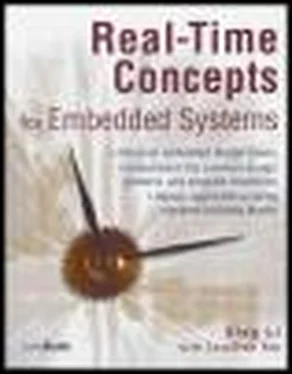· Events of the same type are not accumulated in the event register.
· The occurrence of an event in the event register does not change the execution state of the receiving task, unless the task is already waiting on that event.
· Tasks receive signals synchronously.
· The occurrence of a signal changes the execution state of the receiving task.
· Signals can be handled by user-defined actions or by system-defined default actions.
· Multiple occurrences of the same signal are not cumulative.
· A condition variable allows one task to wait until another task has placed a shared resource in a desired state or condition.
· A condition variable is used to synchronize between tasks but is not used as a mechanism to synchronize access to shared resources.
Chapter 9: Other RTOS Services
A good real-time embedded operating system avoids implementing the kernel as a large, monolithic program. The kernel is developed instead as a micro-kernel. The goal of the micro-kernel design approach is to reduce essential kernel services into a small set and to provide a framework in which other optional kernel services can be implemented as independent modules. These modules can be placed outside the kernel. Some of these modules are part of special server tasks. This structured approach makes it possible to extend the kernel by adding additional services or to modify existing services without affecting users. This level of implementation flexibility is highly desirable. The resulting benefit is increased system configurability because each embedded application requires a specific set of system services with respect to its characteristics. This combination can be quite different from application to application.
The micro-kernel provides core services, including task-related services, the scheduler service, and synchronization primitives. This chapter discusses other common building blocks, as shown in Figure 9.1.
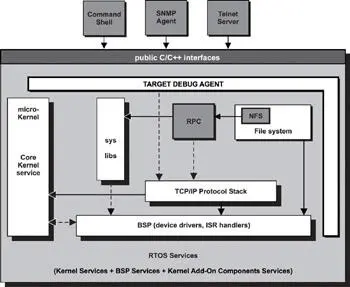
Figure 9.1: Overview.
9.2 Other Building Blocks
These other common building blocks make up the additional kernel services that are part of various embedded applications. The other building blocks include the following:
· TCP/IP protocol stack,
· file system component,
· remote procedure call component,
· command shell,
· target debut agent, and
· other components.
9.2.1 TCP/IP Protocol Stack
The network protocol stacks and components, as illustrated in Figure 9.2, provide useful system services to an embedded application in a networked environment. The TCP/IP protocol stack provides transport services to both higher layer, well-known protocols, including Simple Network Management Protocol (SNMP), Network File System (NFS), and Telnet, and to user-defined protocols. The transport service can be either reliable connection-oriented service over the TCP protocol or unreliable connectionless service over the UDP protocol. The TCP/IP protocol stack can operate over various types of physical connections and networks, including Ethernet, Frame Relay, ATM, and ISDN networks using different frame encapsulation protocols, including the point-to-point protocol. It is common to find the transport services offered through standard Berkeley socket interfaces.
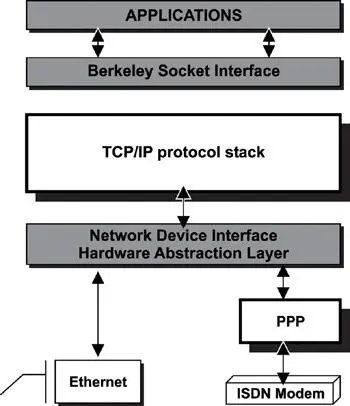
Figure 9.2: TCP/IP protocol stack component.
9.2.2 File System Component
The file system component, as illustrated in Figure 9.3, provides efficient access to both local and network mass storage devices. These storage devices include but are not limited to CD-ROM, tape, floppy disk, hard disk, and flash memory devices. The file system component structures the storage device into supported formats for writing information to and for accessing information from the storage device. For example, CD-ROMs are formatted and managed according to ISO 9660 standard file system specifications; floppy disks and hard disks are formatted and managed according to MS-DOS FAT file system conventions and specifications; NFS allows local applications to access files on remote systems as an NFS client. Files located on an NFS server are treated exactly as though they were on a local disk. Because NFS is a protocol, not a file system format, local applications can access any format files supported by the NFS server. File system components found in some real-time RTOS provide high-speed proprietary file systems in place of common storage devices.
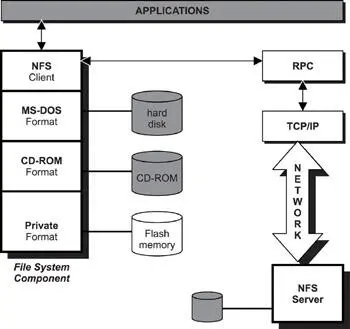
Figure 9.3: File system component.
9.2.3 Remote Procedure Call Component
The remote procedure call (RPC) component allows for distributed computing. The RPC server offers services to external systems as remotely callable procedures. A remote RPC client can invoke these procedures over the network using the RPC protocol. To use a service provided by an RPC server, a client application calls routines, known as stubs, provided by the RPC client residing on the local machine.
The RPC client in turn invokes remote procedure calls residing in the RPC server on behalf of the calling application. The primary goal of RPC is to make remote procedure calls transparent to applications invoking the local call stubs. To the client application, calling a stub appears no different from calling a local procedure. The RPC client and server can run on top of different operating systems, as well as different types of hardware. As an example of such transparency, note that NFS relies directly upon RPC calls to support the illusion that all files are local to the client machine.
To hide both the server remoteness, as well as platform differences from the client application, data that flows between the two computing systems in the RPC call must be translated to and from a common format. External data representation (XDR) is a method that represents data in an OS- and machine-independent manner. The RPC client translates data passed in as procedure parameters into XDR format before making the remote procedure call. The RPC server translates the XDR data into machine-specific data format upon receipt of the procedure call request. The decoded data is then passed to the actual procedure to be invoked on the server machine. This procedure's output data is formatted into XDR when returning it to the RPC client. The RPC concept is illustrated in Figure 9.4.
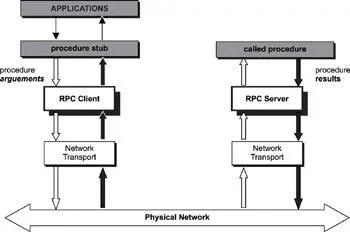
Figure 9.4: Remote procedure calls.
The command shell, also called the command interpreter, is an interactive component that provides an interface between the user and the real-time operating system. The user can invoke commands, such as ping, ls, loader, and route through the shell. The shell interprets these commands and makes corresponding calls into RTOS routines. These routines can be in the form of loadable program images, dynamically created programs (dynamic tasks), or direct system function calls if supported by the RTOS. The programmer can experiment with different global system calls if the command shell supports this feature. With this feature, the shell can become a great learning tool for the RTOS in which it executes, as illustrated in Figure 9.5.
Читать дальше
